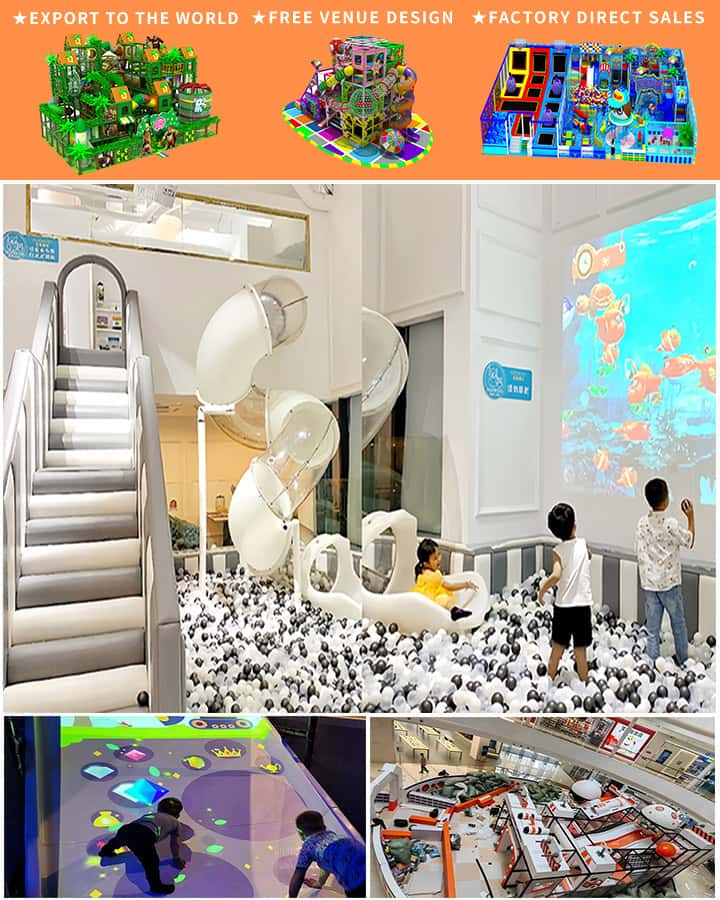Designing an indoor playground requires creativity, safety considerations, and a focus on the developmental benefits for children. Here are some innovative design ideas that can transform any indoor space into a fun-filled haven for kids:
1. Modular Play Structures
One of the latest trends in indoor playground equipment is modular play structures. These versatile pieces can be reconfigured to create different play scenarios, ensuring that the playground remains engaging and challenging over time. Modular designs often feature climbable walls, tunnels, slides, and balance beams, all of which contribute to developing children’s motor skills, coordination, and problem-solving abilities.
2. Interactive Digital Play
Integrating technology into indoor playgrounds has become increasingly popular. Interactive digital screens or augmented reality installations can offer educational content while keeping kids entertained. For instance, climbing walls with integrated games or projection mapping can make physical activity more engaging and mentally stimulating.
3. Soft Play Areas
Safety is paramount when designing indoor playground equipment. Soft play areas filled with cushioned flooring, foam blocks, and soft obstacles allow children to explore and play without the risk of serious injury. These environments are ideal for toddlers and young children who are still developing their motor skills. Plus, soft play zones can be themed to stimulate imaginative play—think mini cities, jungle adventures, or under-the-sea scenes.

4. Multi-Level Play Systems
Multi-level play systems add an extra dimension to indoor playgrounds. These structures typically include various levels connected by ladders, bridges, and slides. Such systems not only provide ample opportunities for climbing and sliding but also encourage social interaction and cooperative play among children. Multi-level designs can cater to different age groups and skill levels, making them a versatile addition to any indoor playground.
5. Nature-Inspired Themes
Incorporating elements of nature into indoor playground design can create a serene yet stimulating environment. Think about using natural materials like wooden logs, faux rocks, and greenery. Treehouse-themed play areas, indoor sandpits, and garden mazes can help children develop a connection with nature while enjoying their playtime indoors.
6. Educational Zones
Play isn’t just about fun; it’s also a valuable learning experience. Educational zones within the playground can include puzzle areas, building blocks, interactive panels, and sensory play equipment. These zones encourage cognitive development, foster teamwork, and promote creative thinking.
7. Customizable Climbing Walls
Climbing walls are a fantastic way to promote physical fitness and confidence. Modern climbing walls for indoor playgrounds can be customized with various textures, colors, and shapes to cater to different age groups and skill levels. Incorporate themes such as mountains, castles, or even space missions to make the experience more thrilling and immersive.
8. Sensory Play Areas
Sensory play areas are crucial for children with sensory processing needs or those who simply enjoy tactile experiences. Include elements like textured walls, water tables, light-up toys, and musical instruments. These areas can be designed to be both calming and stimulating, offering a balanced sensory experience.
9. Themed Adventure Zones
Creating themed adventure zones can transport children to another world. Whether it’s a pirate ship, space station, or fantasy castle, these themed areas provide an immersive experience that captivates imagination. Use storytelling elements, role-play costumes, and themed music to enrich the adventure.
10. Inclusive Play Equipment
It’s essential to design inclusive play equipment that caters to children of all abilities. Incorporate wheelchair-accessible swings, sensory-rich elements, and adaptive climbing walls. Ensure that the flooring is non-slip and safe for all users. Inclusive design makes the playground enjoyable for every child, fostering a community spirit.
In conclusion, designing a successful indoor playground involves a blend of safety, creativity, and educational value. By incorporating these innovative design ideas, you can create a space where children not only have fun but also learn and grow in a supportive and stimulating environment.




